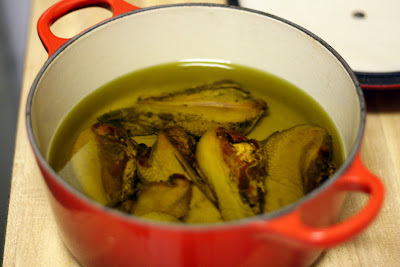My curiosity tends to get the best of me when I see strange cuts of meat at the butcher. I may be in line to buy pork chops, but if I see duck hearts behind the glass, all thoughts of pork go out the window. God help me the day I spot a bull penis.
The other day, I went to one of my favorite butcher's,
Dickson's Farmstand Meats, to pick up some pretty standard fare: lamb chops, bacon, and pork shoulder. As I was picking out my lamb chops, I noticed a small pile of what looked exactly I imagined a lamb tongue would look like. Sure enough, the butcher confirmed that the ugly things that looked just like tongues, were indeed tongues. I never imagined that one could even eat a lamb's tongue, so after seeing them, I had to buy them. I purchased all seven of the tongues, which I assume must be exactly how many lambs the shop had butchered in the past few days because who else in their right mind would purchase the things?
Being from Dickson's, the lamb tongues I purchased were from local, sustainably raised lambs, which I'm going to
assume hope means that my tongues had only touched wholesome things (one can only imagine what Lindsay Lohan's tongue must taste like...eek). In other words, I had to do these tongues justice. My first thought was to braise them which is usually the method I choose when I have no clue how else to cook something, but I wanted do something that was less familiar. After doing some research, I found that confiting was a popular method of cooking lamb tongues.

This marked my first time confiting anything, but the method is pretty standard no matter what meat you choose to confit. The first step is to cure the meat in a mixture of salt and herbs. I purchased about a pound of lamb tongues and used one-and-one-third teaspoons of salt, a minced shallot, a minced garlic clove, a teaspoon of black pepper, and a teaspoon of herbs de Provence. So long as you keep the meat to salt ratio the same, you can experiment with any combination of seasonings. I rubbed this mixture all of the lamb tongues, covered them, and placed them in the refrigerator overnight to soak in all the good flavors.
The next day, I removed the tongues from the refrigerator, rinsed off the seasonings, and patted them dry. I then place the tongues in a cast iron pot, covered them with olive oil, covered the pot, and placed them in a 225 degree oven. I cooked the tongues until they were tender, which took about 3 hours. I then let them cool enough so that I could handle them.
Once cool enough to handle, I peeled the skin off of each tongue and cut off the core. I have to admit that this part made me slightly squeamish as the tongues feel like...tongues. Once I got over that, it was easy as the skin peels right away. Here is how they looked after removing the skins:
I then placed the tongues back into the oil, making sure that there was enough oil to cover them, and put them in the refrigerator for a later use. They will keep for a couple of weeks.
Now that I have a container full of lamb tongue confit, I have a few ideas of how to use them. In salads or over lentils or beans are my first thoughts, but what about you? How would you serve lamb tongue confit?









































